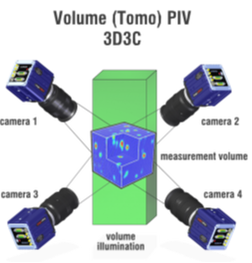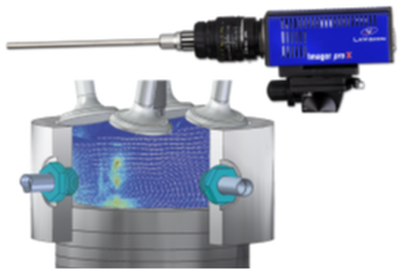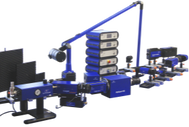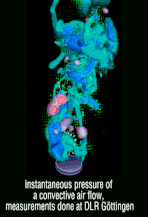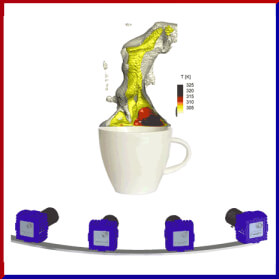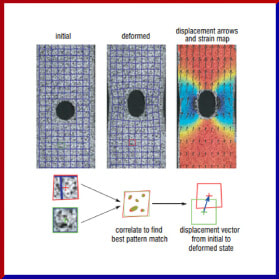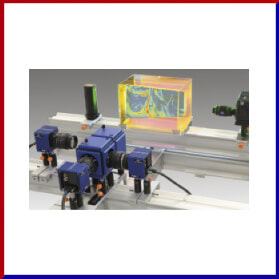Particle Image Velocimetry (PIV)
LaVision is a master at developing Particle Image Velocimetry (PIV) systems. Each system designed using PIV is developed for measuring under specific environments (i.e. under flowing movement in air /fluid motion in water)
With components including continuous wave and pulse lasers, high-speed and sCMOS cameras, all of them conveniently controlled with a precise timing unit, a FlowMaster system can be adapted to a wide range of measurement demands in all fields of fluid dynamics.
With components including continuous wave and pulse lasers, high-speed and sCMOS cameras, all of them conveniently controlled with a precise timing unit, a FlowMaster system can be adapted to a wide range of measurement demands in all fields of fluid dynamics.
2D & Stereo PIV
|
LaVision’s FlowMaster PIV systems can be used for 2D and stereoscopic flow field analysis. FlowMaster 2D measures two velocity components in a plane (2D2C) with one camera. FlowMaster Stereo-PIV is a straightforward extension of the FlowMaster 2D concept and enables the measurement of all three velocity components inside a light sheet (2D3C) using two cameras.
For Stereo-PIV LaVision has developed a unique and patented camera calibration method. This so-called Self-Calibration method uses the original particle images of both cameras to correct even large misalignments between calibration plate and laser light sheet. LaVision’s Self-Calibration method is a standard feature of the Stereo-PIV software in DaVis. basics of 2D cross correlation planar PIV The flow is seeded with small particles which follow the flow. For planar PIV, the particles are illuminated by a thin (laser) light sheet, and the light intensity scattered by the tracer particles is recorded by one or more cameras.
Principle of Stereoscopic PIVWith FlowMaster Stereo-PIV, all three velocity components (u,v,w) in a light sheet are measured (2D3C). It is based on the principle of stereoscopic imaging: two cameras capture the image of the illuminated tracer particles from different angles. Scheimpflug lens arrangements keep all areas of the measurement planes in focus.
advantage of Stereo-PIV Self-Calibration
|
FlowMaster Tomographic PIV
|
FlowMaster Tomographic (Tomo) PIV is an extension of the FlowMaster Stereo-PIV concept and enables the instantaneous measurement of all three velocity components in a complete 3D measurement volume (3D3C).
FlowMaster Tomo-PIV systems use the same laser and camera equipment as in planar PIV setups, i. e. a direct migration from 2D- or Stereo-PIV to Tomo-PIV is straightforward best adding one or two cameras. **Similar to FlowMaster, the Tomo PIV is also capable of self-calibrating, even for 3D reconstruction. Principle of Tomographic PIVA tomographic reconstruction algorithm using the Multiplicative Algebraic Reconstruction Technique (MART) reconstructs the 3D light intensity distribution. 3D cross correlation of interrogation volumes recorded at different instants in time yields the displacement velocity field.
time-resolved Tomo-PIVFor time-resolved Tomo-PIV measurements a time-marching Sequential Motion Tracking Enhancement (SMTE) reconstruction algorithm is used featuring a better reconstruction quality with higher possible seeding density and spatial resolution.
tomographic applicationsFor the applications of the Tomographic PIV, click the brochure here. It explains how tomographic PIV works under different natural environments such as turbulent fuild motion.
|
Time resolved 3d particle tracking
Helium-Filled Soap bubble (HFSB) Generator: Large Scale PIV/PTV in airAir seeding with µm-particles is not suitable for large scale PIV/PTV experiments due to their limited scattering power. Neutrally buoyant Helium-filled Soap Bubbles (HFSB) with a diameter of 0.3 mm and a response time less than 15 µs scatter 10000x more light than µm-particles and, therefore, are suitable for large scale PIV/PTV experiments in the lower subsonic regime.
aPPLICATION: Imaging in a Wind Tunnel for Full Scale Automotive TestingTime-resolved 3D flow fields have been successfully measured behind a serial car in a large wind tunnel at Volkswagen. The field-of-view was 2 m x 1.6 m with a light sheet thickness of 0.2 m. The air flow was seeded with 0.3 mm in diameter Helium-filled soap bubbles applying seeding rates of more than 2 million bubbles per second operating 60 seeding nozzles.
Four high-speed cameras recorded the 3D wake flow at wind speeds of 60 km/h and 120 km/h, respectively. A high-speed laser was used for illumination. LaVision’s Shake-the-Box time-resolved 3D-PTV technique was applied to calculate the time-resolved 3D flow fields. |
Add-ons are unique instruments that are developed on top of the system that is used to further refine the accuracy & the depth of measurements
Add-ons
ENDOSCOPIC PIVEndoscopic PIV is the attachment of a unique endoscope to the camera for measurements small and deep areas. LaVision’s FlowMaster Endoscopic PIV systems need less modifications for such experiments because only 8 mm small holes are needed for the laser beam and the camera viewing port, respectively.
The laser endoscope generates the light sheet and is designed to fit at the front end of the articulated laser guiding arm. The camera endoscope is directly attached to the lens of the PIV camera. This made it ideal for laser imaging under flames or within engines as a long probe. |
|
|
Time-Resolved Particle Tracking Velocity (PTV): shake in boxShake-the-box is the most advanced 3D Lagrangian Particle Tracking Velocimetry (PTV) method for densely seeded flows at highest spatial resolution.
Shake-the-Box is a purely particle-based technique using an Iterative Particle Reconstruction (IPR) technique in combination with an advanced 4D-PTV algorithm using the time-information for track reconstruction. |
PIV Systems Components
Application: Pressure from PIV/PTV
|
Pressure measurements are needed in many research areas and the common measurement method is the use of pressure taps, which is costly and time-consuming and limited to a small number of points. Therefore, groups from several universities and LaVision joined forces in the European NIOPLEX project which led to a Pressure from PIV package in DaVis 10.
The LaVision 4D solver provides direct access to instantaneous and average pressure fields from 2D-, Stereo- and Tomographic PIV data as well as from particle tracks (Shake-the-Box). With only a few clicks, Pressure from PIV together with LaVision’s DaVis 10 software retrieves and visualises average pressure fields from all kinds of PIV and PTV velocity data either imported to or directly computed by DaVis. For time-resolved data, even the instantaneous pressure can be evaluated. |
Continue Reading: Particle Image Velocity (PIV)
RElated Instruments
|
*Pictures shown above are for reference only. Actual product may differ slightly.
**Some products may not be available in all countries. Please contact us for further information and clarification. |
Don't have what you are looking for?
Search here. Alternatively, please contact us for more information.
|


